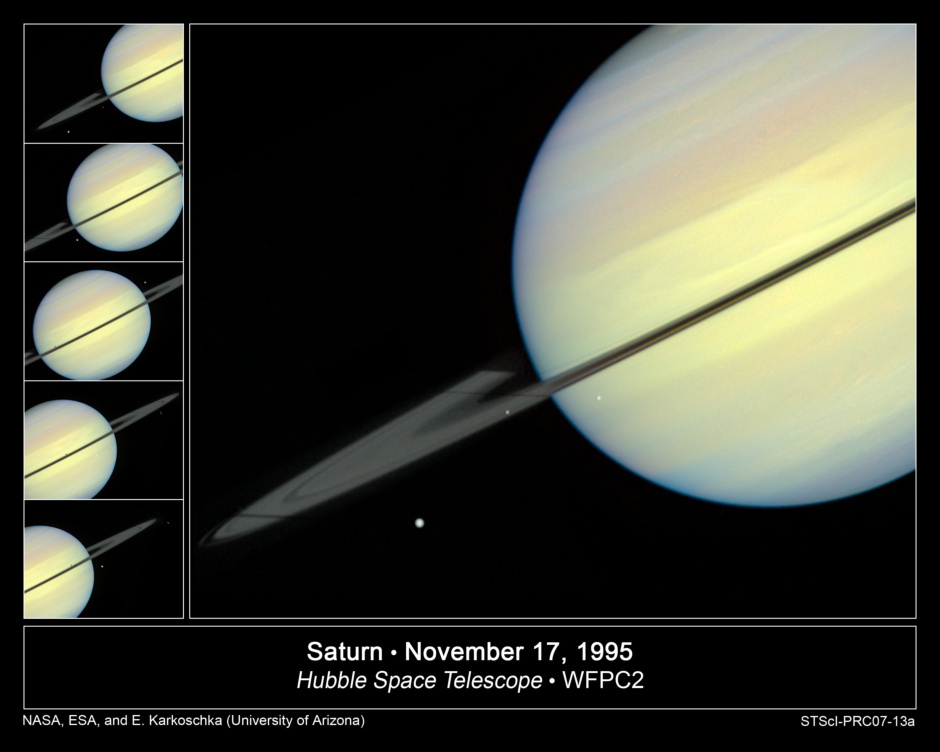이 스틸컷은 토성의 위성인 미마스(Mimas)와 엔켈라두스(Enceladus), 그리고 디오네(Dione)가 토성을 가로질러 지나가는 장면을 이어붙인 것이다.
이 스틸컷들은 허블우주망원경이 촬영한 이미지들로부터 만들어진 동영상에서 뽑아낸 것들이다.
여기서 토성의 고리들은 태양쪽으로 모서리를 향한채로 비스듬하게 경사를 이루고 있는 모습을 보여주는데 이러한 각도는 15년을 주기로 발생하는 것이다.
이처럼 특별한 배열 상태에서는 위성들의 그림자가 토성과 그 고리에 비춰지는 모습을 볼 수 있다.
가장 왼쪽에 보이는 위성이 다이오네이고, 중앙에 보이는 위성이 미마스, 그리고 가장 오른쪽에 보이는 위성이 엔켈라두스이다.
다이오네와 엔켈라두스는 고리위에 긴 그림자를 드리우고 있다.
메인 이미지 왼쪽에 섬네일 이미지들은 토성의 위성들이 토성을 지나가는 'Transit'현상을 보여주고 있는 이미지들이다.
이 이미지들은 1995년 11월 17일에 허블 광대역행성형카메라2의 3원색필터로 촬영되었다.
이 저속 동영상은 토성의 고리가 태양에 대해 직각을 이룬 상태일 때, 토성의 위성인 미마스, 엔켈라두스, 다이오네, 테티스가 토성주위를 공전하는 모습을 보여주고 있다.
각도가 각도인만큼 토성의 고리는 토성표면에 아주 얇은, 거의 보일듯 말듯한 그림자를 드리우고 있다.
토성 위성들의 공전궤도는 거의 토성 고리와 동일한 각도를 이루기 때문에, 이들의 그림자는 고리의 바로위, 행성 표면을 따라 지나가고 있는 것이다.
3개의 위성들은 저마다의 공전궤도상에 눈에 보이지 않는 트랙을 따라 나타나고 있다.
이들 위성들의 공전속도는 토성으로부터 떨어진 거리에 따라 달라진다.
가장 빠른 속도의 위성은 토성에서 가장 가까이에 있는 위성으로 미마스가 여기에 해당된다.
동영상에서는 미마스와 엔켈라두스가 첫번째로 나타난다.
우선 엔켈라두스가 나타나고 미마스가 토성을 가로지르는 경주인양, 엔켈라두스를 뒤쫓아 나타나고 있다.
두개의 위성(미마스와 다이오네)은 그 그림자를 행성위로 띄우고 있지만 엔켈라두스만은 그 그림자가 고리위에 나타나고 있다.
미마스의 경우 그 공전궤도가 약간 기울어져 있기 때문에 그 그림자가 고리에 걸치지 않고 있는 것이다.
동영상에서 마지막으로 나타는 것이 다이오네이다. 왼쪽에 다이오네의 그림자가 고리에 길게 드리워진 모습이 보인다.
동영상의 끝부분에서 세 개의 위성들이 토성을 가로질러갈 때, 토성의 뒷편으로 돌아들어가는 테티스의 모습이 보인다.
이 30초 분량의 동영상은 허블이 촬영한 9시간 30분 분량의 이미지로 만들어진 것이다.
* '허블사이트'의 게시물들은 허블사이트 http://hubblesite.org 의 뉴스센터 자료를 번역한 것입니다.
참고 : 토성과 토성의 여러 달에 대한 다양한 포스팅은 아래 링크를 통해 조회할 수 있습니다.
https://big-crunch.tistory.com/12346948
원문 >
Cut 1>
This movie still captures the moons Mimas, Enceladus, and Dione as they begin their race across Saturn's disk. The still is from a movie created from images taken by NASA's Hubble Space Telescope. It reveals the planet's rings tilted nearly edge-on toward the Sun, an event that occurs once every 15 years. Because of this special alignment, the moons cast shadows on the planet and its rings. Dione is on the far left of the image, Mimas is in the middle, and Enceladus is on the right. Dione and Enceladus are casting long shadows on the rings. The "thumbnail" images on the left are frames from the movie that show the moons transiting the planet.
The images were taken Nov. 17, 1995 with Hubble's Wide Field and Planetary Camera 2, in blue, green, and red filters.
For additional information, contact:
Donna Weaver/Ray Villard
Space Telescope Science Institute, Baltimore, Md.
(Phone: 410-338-4493/4514)
Erich Karkoschka
University of Arizona, Tucson, Ariz.
(Phone: 520-621-3994; E-mail: erich@pirl.lpl.arizona.edu)
Movie1>
This time-lapse movie shows the icy moons Mimas, Enceladus, Dione, and Tethys rounding Saturn when the planet's rings were tilted nearly edge-on toward the Sun. This edge-on alignment occurs once every 15 years.
The rings' shadow appears as a thin, almost invisible line across the planet. Since Saturn's moons orbit mostly in the same plane as the rings, their shadows can be seen skirting the planet's surface just above the rings.
The moons appear to be moving along an invisible race track as they speed along their orbital paths. Their speeds are based on their respective distances from Saturn. The faster moons are closest to the planet. Mimas and Enceladus appear first. Mimas is chasing after Enceladus as the pair race across Saturn. Both moons cast small shadows on the planet, but only Enceladus casts a shadow on the rings. The orbit of Mimas is inclined so that its shadow misses the rings. Dione is the next moon to make its appearance. Its long shadow also tracks across the ring system. As the three moons move across Saturn's disk, the viewer catches a fleeting view of Tethys as it moves behind the planet on the right.
'3. 천문뉴스 > 허블사이트' 카테고리의 다른 글
| 토성 위성들의 Transit 현상 -3- (0) | 2007.11.28 |
|---|---|
| 토성 위성들의 Transit 현상 -2- (0) | 2007.11.28 |
| NGC 1672 (0) | 2007.11.27 |
| 허블망원경을 통해 이룩한 과학적 발견 -12- (0) | 2007.11.24 |
| 허블망원경을 통해 이룩한 과학적 발견 -11- (0) | 2007.11.22 |
